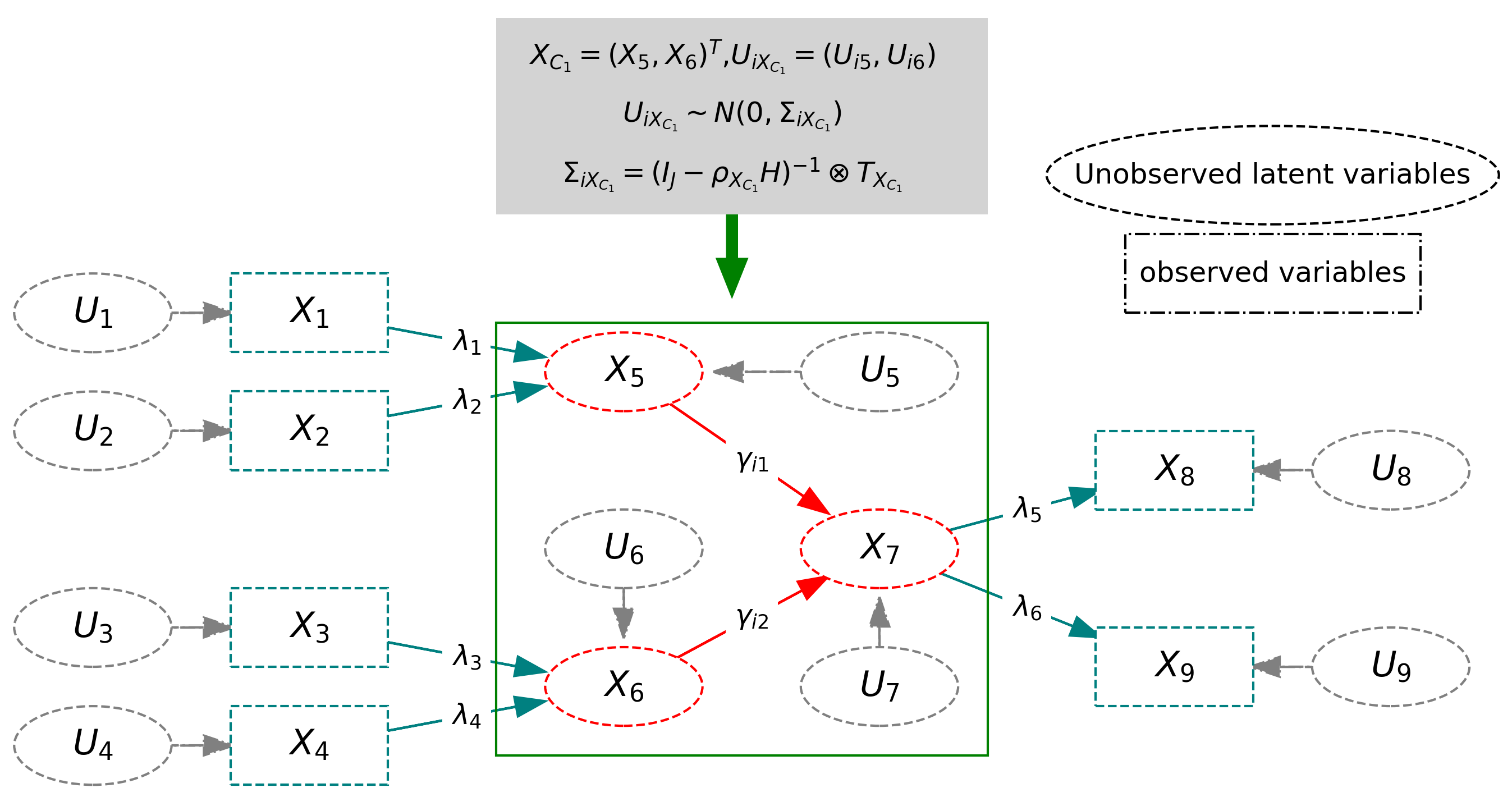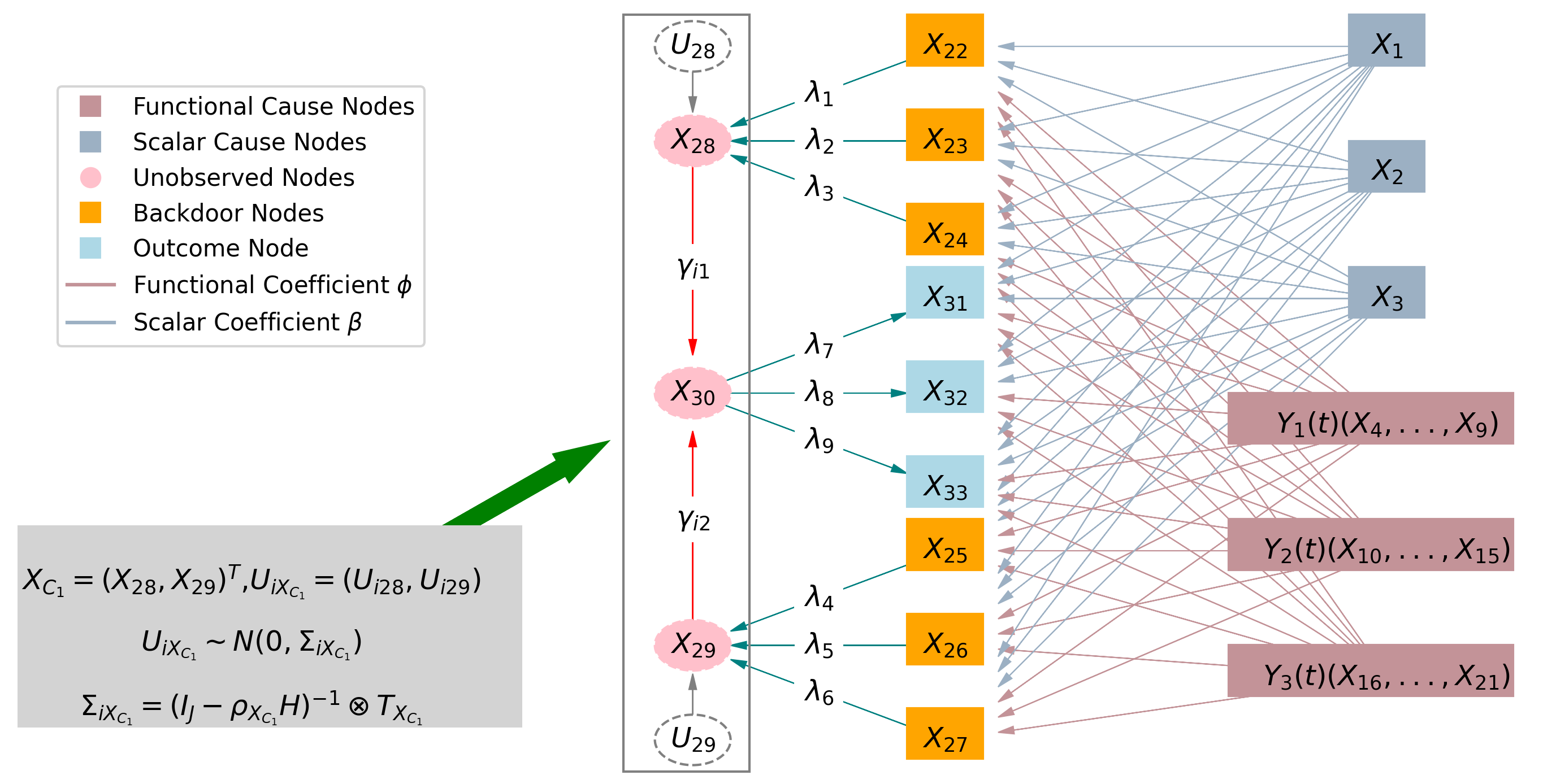- The paper introduces a unified framework that integrates diffusion-based generative modeling with backdoor adjustment to estimate interventions and counterfactuals.
- The model employs a spatio-temporal dynamic structural causal approach to handle partial functional data and heterogeneous resolutions.
- Empirical results show reduced MMD, CRPS, and MSE, underscoring the method’s effectiveness in managing complex unmeasured confounders.
Partial Functional Dynamic Backdoor Diffusion-based Causal Model: A Technical Analysis
Introduction and Motivation
The Partial Functional Dynamic Backdoor Diffusion-based Causal Model (PFD-BDCM) addresses a central challenge in causal inference: robustly estimating interventional and counterfactual distributions in the presence of unmeasured confounders exhibiting both spatial heterogeneity and temporal dependencies. Traditional SCM-based approaches, including DCM and BDCM, are limited by their assumptions of causal sufficiency and static relationships, which are often violated in real-world spatio-temporal data. PFD-BDCM extends the diffusion-based causal modeling paradigm to accommodate partial functional data, multi-resolution variables, and complex confounding structures, providing a unified framework for observational, interventional, and counterfactual queries.
Model Architecture and Theoretical Foundations
PFD-BDCM is built upon a spatio-temporal dynamic structural causal model (ST-DSCM), which generalizes SCMs to account for both spatial and temporal dependencies among unmeasured confounders. The model represents each node in the causal graph with a dedicated spatio-temporal diffusion model, parameterized as a conditional DDIM, and incorporates backdoor adjustment sets as covariates to mitigate confounding bias.

Figure 1: Spatio-Temporal Dynamic Structural Causal Model with twelve exogenous and endogenous nodes, highlighting unmeasured confounders with spatial and temporal structure.
The architecture is further extended to handle partial functional data via basis expansions, resulting in the Partial Functional Spatio-Temporal Dynamic Structural Causal Model (PFST-DSCM). This enables the model to represent variables observed at heterogeneous resolutions and to perform dimensionality reduction in the functional space.

Figure 2: Partial Functional Spatio-Temporal Dynamic Structural Causal Model with 33 nodes, including functional nodes and unmeasured confounders with spatio-temporal dependencies.
The encoder-decoder structure of PFD-BDCM is formalized as follows:
- Encoder g: Maps observed data and backdoor variables to a latent representation, serving as a proxy for exogenous noise.
- Decoder h: Reconstructs the observed variable from the latent representation and backdoor variables.
The forward and reverse diffusion processes are adapted from DDIM, ensuring deterministic mappings necessary for counterfactual reasoning. The model is trained by minimizing the denoising objective, with each node's diffusion model trained independently and in parallel, conditioned on its backdoor set.
Theoretical Guarantees
The paper establishes error bounds for counterfactual estimation, formally linking the reconstruction error of the encoder-decoder pair to the accuracy of counterfactual predictions. Under monotonicity and invertibility assumptions, the encoded latent variable is shown to be an invertible transformation of the true exogenous noise, ensuring identifiability of counterfactuals. In the multivariate case, the error bound scales with the Lipschitz constant of the decoder and the condition number of the encoder's Jacobian, providing a direct connection between model capacity and causal estimation fidelity.
Practical Implementation
Training and Inference
- Training: Each node's diffusion model is trained using observational data and its backdoor adjustment set. The loss function is the standard diffusion denoising objective, with additional conditioning on interventions when present.
- Sampling: For observational and interventional queries, the model samples in topological order, fixing intervened nodes and propagating generated values as backdoor inputs. For counterfactual queries, the encoder maps factual observations to latent noise, which is then used in the decoder under the counterfactual intervention.
Pseudocode Outline
1
2
3
4
5
6
7
8
9
10
11
12
|
for epoch in range(num_epochs):
for x_k, x_backdoor in data_loader:
t = random.randint(1, T)
noise = torch.randn_like(x_k)
x_noisy = sqrt(alpha_t) * x_k + sqrt(1 - alpha_t) * noise
loss = mse_loss(
noise,
epsilon_theta_k(x_noisy, x_backdoor, t)
)
optimizer_k.zero_grad()
loss.backward()
optimizer_k.step() |
1
2
3
4
|
def counterfactual(x_k_factual, x_backdoor_factual, x_backdoor_cf):
z_k = encoder_k(x_k_factual, x_backdoor_factual)
x_k_cf = decoder_k(z_k, x_backdoor_cf)
return x_k_cf |
Computational Considerations
- Parallelization: Node-wise independence during training allows for efficient parallelization across nodes.
- Scalability: The model scales linearly with the number of nodes, but the complexity of the diffusion process and the size of the backdoor sets can impact memory and compute requirements.
- Resolution Handling: Basis expansions for functional data enable the model to handle variables observed at different temporal or spatial resolutions.
Empirical Evaluation
The empirical results demonstrate that PFD-BDCM achieves superior performance compared to PFD-DCM and other baselines across synthetic and real-world datasets. In simulation studies, PFD-BDCM consistently yields lower MMD, CRPS, and MSE for observational, interventional, and counterfactual queries, particularly as sample size increases. The model's advantage is most pronounced in counterfactual estimation, where the explicit use of backdoor adjustment sets leads to substantial reductions in estimation error.
In a real-world application to spatio-temporal air pollution data across Chinese provinces, PFD-BDCM outperforms PFD-DCM in matching the true observational distributions of multiple pollutant indicators, as measured by MMD. These results validate the model's capacity to handle high-dimensional, partially observed, and functionally heterogeneous data with complex confounding.
Implications and Future Directions
PFD-BDCM provides a principled approach for causal inference in settings characterized by unmeasured confounding, spatial heterogeneity, and temporal dependencies. The integration of diffusion-based generative modeling with backdoor adjustment and functional data analysis represents a significant methodological advance, enabling robust estimation of interventional and counterfactual distributions in complex domains.
The theoretical results establish a direct link between autoencoding fidelity and counterfactual accuracy, suggesting that advances in diffusion model architectures and training techniques can translate into improved causal inference performance. The framework is broadly applicable to domains such as environmental science, epidemiology, and econometrics, where functional data and unmeasured confounders are prevalent.
Future research directions include:
- Scaling to ultra-high-dimensional functional data via tensor decompositions.
- Automated identification of backdoor sets using causal discovery algorithms.
- Integration with temporal graph neural networks for non-stationary processes.
- Real-time deployment in policy decision support systems.
Conclusion
PFD-BDCM advances the state of the art in causal inference by unifying diffusion-based generative modeling, backdoor adjustment, and functional data analysis within a single framework. The model's theoretical guarantees, empirical performance, and practical scalability make it a valuable tool for addressing causal questions in complex, high-dimensional, and partially observed environments. The approach opens new avenues for methodological development and application in domains where traditional causal inference methods are inadequate.



